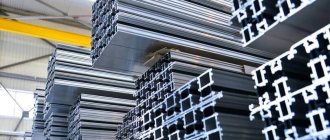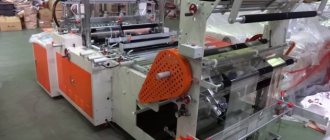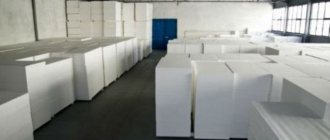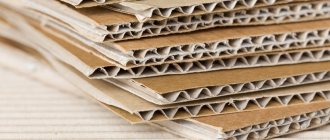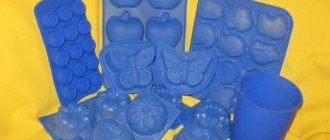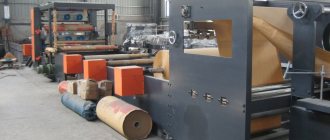The production of plastic windows begins with cutting the profile and glazing beads, cutting drainage holes.
Machines called saws are used to cut profiles. According to the type of cut, they are single-head, which cuts the material at an angle of 90 degrees, and double-head, cutting at an angle of 45 degrees.
In single-head saws, dimensions are set manually using a roller conveyor equipped with a measuring device. For others - automatically or using an electronic scoreboard and vernier. Saws can be installed permanently or on a work table. They also differ in the type of clamps - mechanical or pneumatic.
Depending on the model, one of three options for feeding the saw blade tool is implemented: pendulum, with top or bottom feed. The type of feed and the size of the saw blade determine the possible cutting sizes.
The saws can be additionally equipped with a cooling system. The most widely used are saws with pendulum blade feed, for example, double-head saws EMMEGI NORMA, Yilmaz KD 402. An important stage of manufacturing is welding, including installation of workpieces, heating of the welded surfaces, compression and cooling of the seam. Welding machines are used for profile welding. Depending on the needs of production - single, small-scale or serial, one-, two-, three-, four- or six-eight-head welding machines are selected. They differ in the number of corners that are cooked at the same time. An example of an economical single-head unit for welding a profile with a height of 140 mm is the Slovakian model Aluma APOLO. It has safe control and a fully automated welding process, easily adjustable by angle. Processing of the ends of the profiles is carried out on end milling machines. They are available in stationary or desktop installation options. Moreover, the latter have one cutter, and the stationary ones, depending on the brand, have one or two.
An example is the ALUMA ARCUS P model, which is designed for milling elements within 20-90-20 degrees, has automated operational transitions and can have an additional function for cleaning the corner of the window frame structure.
Holes for handles, hinges and locks on profiles are processed on desktop or stationary copy-milling machines. The copying device ensures automatic operation of the tool and eliminates the possibility of operator error. The use of desktop machines is limited by the ability to make holes of different configurations in plastic. To drill triple holes for the handle, in this case, a drilling machine with a three-spindle head or drill installed on it is used.
Stationary machines, most of them equipped with a three-spindle head, solve this problem immediately and in a complex. Examples of stationary models are Atlas, ALUMO and Daizer, portable ones are Omurzak PRF-300. After welding work, the seams in the corners of PVC windows are cleaned and the sagging on the outer surfaces is removed. This is done with manual or pneumatic machines. The former are limited in application because they do not perform some operations, for example, end processing. Pneumatic machines are divided into “large” machines for processing ends and “small” ones for front surfaces. Pneumatic machines for cleaning non-standard structures are also produced.
For small-scale production, it is more economical to use stationary two- or three-sided machines. They are equipped with quick-change cutters and have a centering system that ensures precise positioning of window elements at an angle of 45 degrees, but they can only process profiles of limited sizes.
In mass or large-scale production, the use of CNC machines that store thousands of different standard sizes in memory is justified. Glass installation is carried out on special stands, which are a durable steel structure with an assembly table. On the table, fittings, blinds and additional profiles are installed on the window elements.
There are also automated lines for the production of windows, consisting of blocks of equipment for cutting, processing, welding, stripping, and laying finished sashes. Such lines provide high productivity and excellent quality of finished products.
Production of plastic windows
Plastic windows have become a trend in the construction industry and occupy first place among windows made from other materials.
Types of plastic windows
They are environmentally friendly, energy saving, but at the same time very easy to use. It takes a lot of effort to make them.
To start production you need to fulfill the necessary requirements:
- First you need to take care of the premises for the equipment of the manufacturing workshop.
- There must be enough space in the room to accommodate the necessary equipment.
- Workers had to have space and comfort to work.
- The minimum area for a workshop is 50 square meters.
- It is better to rent a room in an industrial zone, where rent is lower than in other areas.
- It is better to equip office space in places where there are a large number of people who can become potential customers.
- The equipment must correspond to the production capacity.
To start production, you can purchase basic equipment. At first it will be enough. In this case, it is better to use equipment from German manufacturers, but it costs a lot of money. French equipment for the production of windows has the characteristics of the domestic market, but costs in euros.
To save a little, you can buy equipment from Turkish manufacturers. Its price will suit a novice entrepreneur. Machines for producing windows are inexpensive, but their service life is shorter.
Another option is to use used equipment. To increase productivity, it is necessary to monitor the proper operation of equipment.
Profitability of production of metal-plastic windows
Plastic windows are installed in all new buildings or renovation houses.
The costs of organizing a business can be divided into capital and current.
Capital costs include the price of a line for the production of double-glazed windows - 1,365,000 rubles.
The amount of these costs will be partially included in the cost of the finished product. And it will fully pay for itself over time. Current costs include the cost of materials - 4290 rubles per 1 m2, in terms of 20 finished units per shift, with an average size of 1.68 m2 and the number of shifts per month - 22, you can get a total consumption of materials per month - 3,160,000 rubles.
- The price of one product is 9,500 rubles.
If all the windows produced are successfully sold, you can get 4,180 thousand rubles in profit. Subtract the cost of materials, the cost of maintaining the premises and the wages of workers, resulting in 670 thousand rubles of net profit. The profitability percentage is 19% - a fairly high figure, it indicates a quick payback on invested capital costs, this will happen in a year and nine months, under favorable conditions and constant prices for components.
Personnel decides everything!
The choice of equipment for the production of metal-plastic windows is not the last problem for an entrepreneur. Personnel selection is a crucial moment. Production requires experience and knowledge, so it is necessary to select people who are professionals in the craft. In addition to workers, you should hire:
- engineer;
- sales manager;
- a marketer who monitors the state of the market.
Sometimes directors hire a specialist in setting up and selecting equipment for the manufacture of plastic windows. This manipulation significantly saves management time at all stages.
Additionally, you should hire a specialist to replace and audit equipment for the production of PVC windows.
Equipment for the production of PVC windows
Business plan for the production of PVC windows
Features of choosing a room
The area of the premises directly depends on the volume of production. The company plans to produce standard double-leaf windows measuring 1400*1200. To open a workshop for the production of PVC windows, which will produce 20 designs per shift, a room of 200 square meters is sufficient. m. It is worth remembering that the ceiling height should be more than 3 meters.
There should be a warehouse for finished products nearby.
Machines for the production of metal-plastic structures will not be able to work without electricity. The supply voltage should be 380V/50Hz. The optimal room temperature is 18° C, otherwise the production technology may be disrupted.
a good ventilation system must be created in the room . Particular attention should be paid to creating a lighting system. General lighting is provided throughout the workshop area, and local “light” is provided for individual areas.
Recruitment
To organize a small enterprise for the production of PVC windows, you need to hire about 10 people and install a special program.
Such a program will calculate the cost of metal-plastic structures with the smallest errors and provide all the information necessary for production.
Control
The production manager should control the production process, and the chief technologist will be able to check whether the finished product meets generally accepted standards and customer requirements? He must also distribute tasks among workers and control the technological process .
The enterprise must also have an engineer who will monitor the operation of the equipment and, if necessary, eliminate breakdowns. The workforce must include at least 7 people, one of whom must be a storekeeper who receives or dispatches goods. The optimal layout of the technological line and the composition of production sites are shown below.
Capital expenditures
To open a plant for the production of PVC windows with a capacity of 20 finished products per shift, it is necessary to purchase the following equipment:
- Double-head saw with front blade connection – 372,000 rubles;
- Automatic corner cleaning machine (Yilmaz CA) -225,000 rubles;
- Face milling machine (Yilmaz km-212) – 30,000 rubles;
- Double-head welding machine – 411,600 rubles;
- Equipment for cutting reinforcement – 9,000 rubles;
- Copy milling machine (Yilmaz FR-225) – 106,400 rubles;
- Remezza compressor – 26,000 rubles;
- Machine for creating drainage holes - 86,000 rubles;
- Automatic saw for cutting plastic beads – 99,600 rubles;
The total cost of a complete set of equipment is 1,365,000 rubles.
Costs for delivery and installation of equipment – 50,000 rubles;
Other expenses (for obtaining a license, certificates) – 50,000 rubles.
Total capital costs: 1,465,000 rubles.
Calculation of the cost of materials for the production of PVC windows
The cost of materials required for the manufacture of double-glazed windows
Consumption rate, cost per unit of materials, financial costs (rub.) per 1 sq. Product meter:
- Glass (C-300 rub./sq. m): cost rate – 2 sq. m. m; cost of consumption - 600 rubles;
- Shell (C-100 rub./m): cost rate – 4 m; cost of consumption - 400 rubles;
- Butyl (C-35 rub./kg): cost rate – 0.1 kg/sq. m; cost of consumption - 3.5 rubles;
- Other consumables per 1 sq. meter of products – 200 rubles.
Total costs for production of 1 sq. meter of double-glazed window - 1203.5 rubles.
Cost of materials needed to create a metal-plastic structure:
- PVC profile (C-1000 rub./m): cost rate – 0.5 m/sq. m; cost of consumption - 500 rubles;
- Rolled metal (C-582.5 rub./m): cost rate – 1 m/sq. m; cost of consumption - 582.5 rubles;
- Components and other consumables – 2000 rubles.
Total: RUB 3,082.5/sq. m.
The total cost of materials for the production of 1 sq. meter of products - 4,286 rubles.
Material costs per month: 22 shifts * 20 finished products * 1.68 sq. m* 4,286 rubles = 3,168,000 rubles.
Monthly income for the month (taking into account the price of the finished product - 9,500 rubles): 22 shifts * 20 units of finished products * 9,500 rubles = 4,180,000 rubles
Fixed monthly costs
- Rent of production premises and warehouse – 50,000 rubles;
- Utility bills – 25,000 rubles;
- Salary of workers (10 people) – 100,000 rubles;
- The cost of materials and components for production is 3,168,000 rubles.
Total costs per month: 3,343,000 rubles.
Income tax (20%) – 167,400 rubles.
Total expenses: 3,510,400 rubles.
Manufacturing technology
The main thing in the production of a metal-plastic window is the profile. The quality must be of the highest level, the strength of each machine for the production of PVC windows affects the result and profit. The service life depends on this element.
Manufacturing stages
First, the profile is cut according to the specified dimensions, frames and sashes are produced.
At the second stage of manufacturing, strength is added to the reinforcing profile. Its dimensions must match the dimensions of the plastic profile. Both components are connected to each other.
Next you need to do the milling. Here it is necessary to remove the moisture accumulated in the middle of the profile. To do this, holes are made using a milling cutter.
In order to dry the window profile, we make holes with a milling cutter
The next stage is the installation of fittings. The chassis is the fittings, so it must be of high quality.
After this, the parts are assembled into one structure - for this, everything is welded and the seams are cleaned.
After this work, the installation of glass begins. It must be of high quality. The glass is installed in the frame and fixed with aluminum. Then a second sheet of glass is placed and pressed.
Assembly, crimping and filling of double-glazed windows
And to create a profile, fittings are installed. It is she who holds all the structures in the castle.
Components and consumables
The PVC profile forms the basis of the frame for plastic windows.
For the production of metal-plastic structures, the following main components will be needed:
- PVC profile;
- rolled metal;
- glass;
- butyl;
- shell.
The table shows the consumption rates of component materials for the production of 1 m2 of windows and their cost:
| Name of material | Cost rate | Cost of consumption, rubles |
| PVC profile | 0.5 m/m2 | 500 |
| glass | 2 m2 | 600 |
| butyl | 0.1 kg | 5 |
| shell | 4 m | 400 |
| rolled metal | 1 m2 | 585 |
| other components | — | 2200 |
The total cost of producing 1 m2 of window construction will cost 4,290 rubles.
Production costs
To start production, initial investments are required. Considering how the business will be conducted, expenses are divided into two groups.
Direct costs required for production:
- Renting premises – you should look for a good premises outside the locality.
- Expenses for equipment needed for production.
- The cost of production equipment depends on the country of manufacture, the degree of novelty, and condition.
- Expenses for the purchase of materials necessary for manufacturing, such expenses are incurred monthly.
- Paying staff is a monthly, permanent expense.
- Utility costs. These include electricity and water bills.
Utility bills are one of the expense items
Indirect waste is necessary, although it has nothing to do with production:
- To register, a certain amount is required to purchase a license and certificates. These documents are necessary for production.
- Advertising creation - product promotion is necessary for successful business.
- Tax expenses amounting to twenty percent of all profits.
Equipment needed for production
For an enterprise to be successful, production machines are needed. Therefore you should purchase:
- saw for cutting the profile according to size;
- saw for cutting glazing beads;
- machine for fastening the reinforcing profile;
- machine for making drainage holes;
- milling machines;
- profile welding equipment;
- end milling machine;
- machine for cleaning the profile surface;
- installation for the production of glazing frames;
- profile bending machine;
- press for processing corners.
Corner press for windows
In addition to the above equipment, it is necessary to install hoods to prevent dust from production from accumulating in the room. Additionally, you need to purchase equipment for assembling windows: washing machines, lifting finished products.
Production technology
As a rule, window manufacturers do not manufacture the components themselves. Therefore, the production technology is an assembly that is carried out in the following sequence:
- cutting profiles to specified sizes and cutting corners;
- cutting and installation of reinforcing elements in profiles;
- milling of drains;
- welding of a box from profiles;
- cleaning corners, which involves removing excess plastic;
- installation of jumpers;
- gluing internal seals;
- manufacturing the inner sash according to the same scheme;
- glass cutting;
- production of double-glazed windows by gluing two glasses and spacers between them;
- installation of fittings and installation of double-glazed windows.
Relevance of production
Enterprises engaged in the production of plastic windows are in great demand among individuals and construction companies. Consumers want a quality product, but they want it at a low cost. Plastic windows are ordered by companies involved in the installation of metal-plastic windows.
Profile windows are distinguished by their simplicity, at the same time they are durable, have excellent thermal insulation and sound insulation properties. For these reasons, most people are happy to replace old windows with profile ones. Since the construction of buildings is very active at the present time, the production of windows will always be relevant.
According to the assortment, windows are divided only into white and laminated, and they are created according to the same principle. But window models can be single-leaf, double-leaf, three-leaf or even four-leaf.
Four-leaf pvc window
But even in this case, the windows are manufactured using the same equipment.
Each window is made to order and to individual sizes. If a large batch of windows is ordered for the construction of multi-story buildings, in this case all windows are made according to a single template size. In addition, there is template modeling of windows.
Risk and competitor assessment
The owner of a business producing plastic windows may face the following risks:
- price dumping by large companies;
- increase in the cost of transportation and components;
- dependence on suppliers;
- drop in demand.
The most serious problem is high competition, which leads to decreased demand. Price dumping by large companies can also reduce profits. To some extent, a unique selling proposition allows you to overcome these negative factors. This could be a wider range than competitors, free delivery, a longer warranty period, higher quality fittings, etc.
Recommendations
Production control is entrusted to the manager, while the technologist must monitor compliance with standards. His task includes the distribution of tasks between workers and control over the process itself.
The engineer's responsibilities include monitoring equipment and carrying out repair work in case of breakdown. Finished products go to the storekeeper, who ensures their storage.
The production of metal-plastic windows is a very profitable business that can bring considerable income. However, in order to maximize profits, you first need to purchase high-quality equipment that will serve faithfully for many years.
When choosing a press for finishing, you should pay attention to the fasteners of the unit itself.
Before purchasing this equipment, pay attention to all components
Manufacturers of cheap equipment often skimp on bolts; the device easily fails and causes defects on the outer layer of plastic parts. It can be difficult to replace fasteners; during operation, they sit tightly on the panels of the unit.
And a machine for bending plastic parts actually resembles a lottery ticket; most machine manufacturers neglect the strength of the moving equipment.
The profile bends under high pressure, and the durability of the material decreases significantly. When selecting equipment for your own workshop, you must carefully study the configuration of the device and the reputation of the manufacturer.
Filling the mini-workshop should be done under the guidance of an experienced specialist; he will help mark out areas and select additional parts.
Components of automatic window production line
Since the production of metal-plastic windows is considered a profitable business and the demand for automated lines is growing, the number of companies offering their equipment is also increasing.
PVC profile cutting saw
The most common installations are from brands such as Yilmaz, Kaban, Nissan, Nikman, Caliber, Oskar, Startech. Equipment from different manufacturers may vary significantly, but there is always the opportunity to purchase additional equipment. According to the technological process, the following basic equipment is required for the manufacture of window structures:
- profile cutting saw;
- welding machine;
- milling machine;
- angle cleaning machine;
- cutting saw;
- glazing stand.
This set of line elements for the production of double-glazed windows is designed for a maximum load of 15 - 20 windows per shift. Additionally you can purchase:
- extruder;
- washing machine;
- demineralizer
Mechanisms and components of lines from different manufacturers differ in power, dimensions, and output.
The table saw cuts the profile according to the specified parameters. It can cut at different angles - 15o, 45o, 90o. Equipped with mechanical clamps and rubber supports to reduce vibration. Characteristics:
- operates from a 220V power supply;
- weight - 30 kg;
- dimensions 56*45*45 cm;
- the cost of the saw is 372 thousand rubles (Yilmaz).
The welding machine is designed to connect the components of a PVC structure at various angles. Automatic heating temperature control, an emergency stop button, and the presence of rubber body supports ensure its safe operation. Specifications:
Angle cleaning machine for PVC profile
- power – 1.5 kW;
- compressed air supply – 35 l/min;
- welded angles - all in the range from 0° to 180°;
- profile width – maximum up to 130 mm;
- machine dimensions – 65*65*52 cm;
- weight – 120 kg;
- cost – 411 thousand rubles (“HEGSAN”).
The milling machine is designed to create holes and grooves of various sizes in aluminum profiles. The holes further serve as places for fastening fittings and connecting various components provided for by the technological process. Characteristics:
- power – 1200 W;
- power supply – 220V;
- cutter rotation speed – up to 23000 rpm;
- dimensions – 55*46*55 cm;
- weight – 27 kg;
- cost – 106 thousand rubles (Yilmaz model).
The angle cleaning machine is designed for cutting off irregularities and excess formed after welding work. Characteristics:
- weight – 26 kg;
- control type – manual;
- dimensions – 68*57*54 mm;
- cost – 225 thousand rubles (Yilmaz).
A notching saw is necessary for drainage holes. This is a desktop unit, powered by 220V power. Characteristics:
Glazing stand for assembling plastic windows
- control type – manual;
- power – 800 W;
- weight 26 kg;
- rotation speed – 3000 rpm;
- dimensions – 56*45*45 mm;
- cost – 86 thousand rubles.
The glazing stand is designed to collect finished parts of the window structure. It allows you to accurately simulate the installation of a window and facilitates the glazing process and the adjustment of fittings. The cost of the stand is 160 thousand rubles.
The kit can be supplemented with saws for cutting glazing beads, a compressor, and equipment for cutting reinforcement. The price of a window production line can be 1,365,000 rubles. The costs of transportation and installation should also be added here if the manufacturer did not take them into account in the price of the automated line - 50 thousand rubles.


